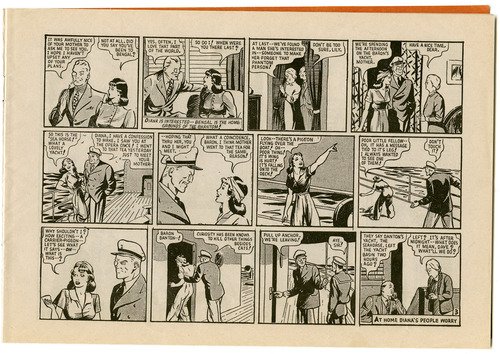In Memoriam
In memory of Australians and New Zealanders who served their countries, ANZAC Day marks the first major military action fought in WWI …
In memory of Australians and New Zealanders who served their countries, ANZAC Day marks the first major military action fought in WWI. The poet Leon Gellert, who penned the following poignant words, was 23 when he landed on Anzac Beach in 1915.
We still remember them, 109 years later.
The Last To Leave
by Leon Gellert (1892–1977)
The guns were silent, and the silent hills
had bowed their grasses to a gentle breeze
I gazed upon the vales and on the rills,
And whispered, ‘What of these?’ and ‘What of these?’
These long forgotten dead with sunken graves,
Some crossless, with unwritten memories
Their only mourners are the moaning waves,
Their only minstrels are the singing trees
And thus I mused and sorrowed wistfully
I watched the place where they had scaled the height,
The height whereon they bled so bitterly
Throughout each day and through each blistered night
I sat there long, and listened – all things listened too
I heard the epics of a thousand trees,
A thousand waves I heard; and then I knew
The waves were very old, the trees were wise:
The dead would be remembered evermore—
The valiant dead that gazed upon the skies,
And slept in great battalions by the shore.
Words sourced from allpoetry.com
Potato Palaver
I don’t often make Croatian style potato pancakes as it is a bit of a palaver, to be honest. Last week, however, I suddenly decided I would revisit my roots and make them. Subsequently, when I was brainstorming ideas to experiment with risoprinting effects, I thought it would be fun to create a step-by-step illustrated recipe to share – so here we are.
I don’t often make Croatian style potato pancakes as it is a bit of a palaver, to be honest. That comes from this modern style of cooking dinner where you arrive home from work, throw your hands up in the air in despair and throw whatever is in the fridge into a stir-fry, or salad bowl. Last week, however, I suddenly decided I would revisit my roots and make them.
Subsequently, when I was brainstorming ideas to experiment with risoprinting effects, I thought it would be fun to create a step-by-step illustrated recipe to share – so here we are. As legibility was important, I kept the texture to a minimum under the text, and did not include any misaligned registratation effects.
When researching potato pancake recipes – according to Professor Google – I found no one else in the world seems to make them using this same method. My friend suggested it was a secret family recipe, but while that’s an exciting notion, it can’t be true, as questioned, my mum said both her own mother and my dad’s Ukrainian mother made them this way. Also, it utilises the same dough as potato dumplings, the recipe of which is commonly known.
One of my sisters says she usually only makes these when she has leftover mashed potato, and suggested that perhaps grandmas all over the countryside did so, but never passed the method on. It seems odd to me. Surely other people hailing from that part of the world have done the same? If you have or know of anyone who has, please let me know! Otherwise, feel free to try the recipe out yourself.
The Exuberance of Cecil Beaton
 First edition of The Blessing, by Nancy Mitford with cover art by Cecil BeatonRecently I started reading Nancy Mitford’s book The Blessing, which, a few chapters in, is proving very entertaining. I first spotted this first edition book on a shelf in an op shop (thrift store), my eye caught by the author’s name as well as the colourful though tattered spine.
First edition of The Blessing, by Nancy Mitford with cover art by Cecil BeatonRecently I started reading Nancy Mitford’s book The Blessing, which, a few chapters in, is proving very entertaining. I first spotted this first edition book on a shelf in an op shop (thrift store), my eye caught by the author’s name as well as the colourful though tattered spine.
I had heard of Nancy Mitford (1904–1973), but I didn’t know much about her life. One of the famous Mitford sisters, she was a novelist, biographer and journalist. The book The Blessing, is considered one of her best, and was dedicated to her very good friend Evelyn Waugh. He told Mitford he found the book, “admirable, deliciously funny, consistent and complete, by far the best of your writings”.
My eye was caught by the illustration; the cover artwork of this first printing in 1951 is by Cecil Beaton and through the rearing horse, and tilting angles evokes a madcap adventure with the heroine’s young child (the ‘blessing’ of the title) at its centre.
 Portrait of Coco Chanel
Portrait of Coco Chanel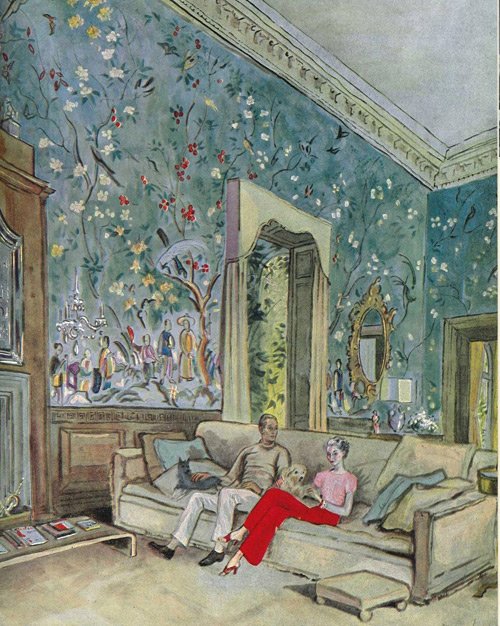 Cecil Beaton (1904–1980) was a prolifically creative person: ‘a fashion, portrait and war photographer, diarist, painter, interior designer and an Oscar-winning stage and costume designer for films and the theatre’. [Wikipedia] I have always admired Beaton’s dedication to detail in his drawings in particular: what patience he had in faithfully depicting the intricacies of interior décor in his portraits of the wealthy! The wallpaper patterns especially impress me, and it is no wonder after all, for he was also a textile designer, and his fabric designs were used by Balenciaga, Dior and Lanvin. (Read more here.)
Cecil Beaton (1904–1980) was a prolifically creative person: ‘a fashion, portrait and war photographer, diarist, painter, interior designer and an Oscar-winning stage and costume designer for films and the theatre’. [Wikipedia] I have always admired Beaton’s dedication to detail in his drawings in particular: what patience he had in faithfully depicting the intricacies of interior décor in his portraits of the wealthy! The wallpaper patterns especially impress me, and it is no wonder after all, for he was also a textile designer, and his fabric designs were used by Balenciaga, Dior and Lanvin. (Read more here.)
Here is a small collection of Beaton’s exuberant illustrations that show a joyful sense of colour and playful riot of pattern and texture.
Images from Pinterest
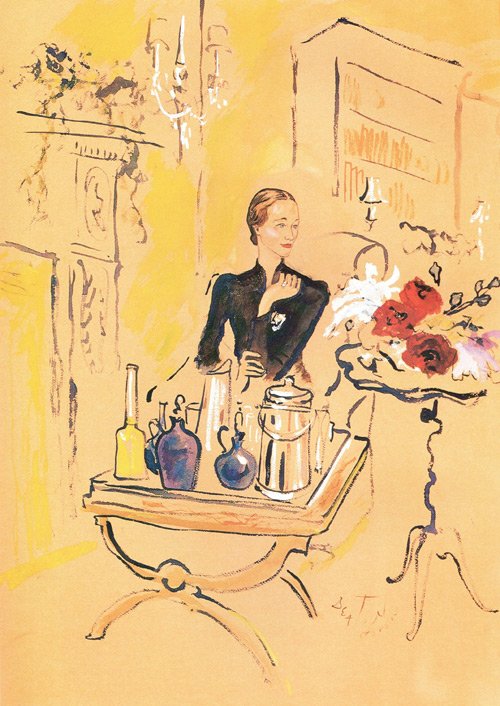 Portrait of the Duchess of Windsor
Portrait of the Duchess of Windsor Beaton's accessories for Vogue magazine
Beaton's accessories for Vogue magazine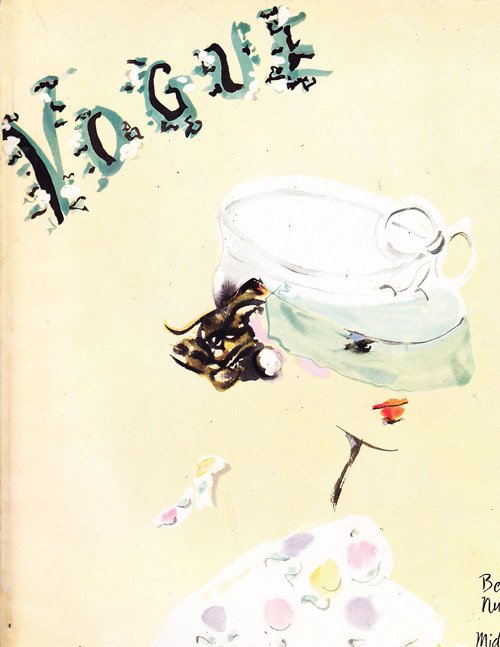 Vogue cover, June 1935
Vogue cover, June 1935 Vogue cover, July 1935
Vogue cover, July 1935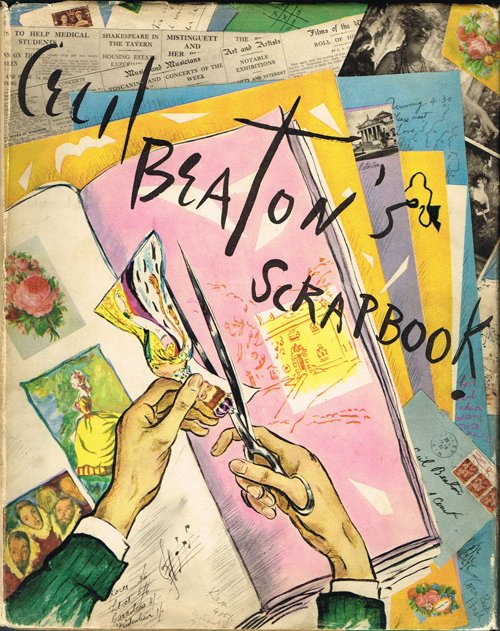 Front cover of one of his personal scrapbooks, full of society photographs
Front cover of one of his personal scrapbooks, full of society photographs Back cover of Cecil Beaton's scrapbook
Back cover of Cecil Beaton's scrapbook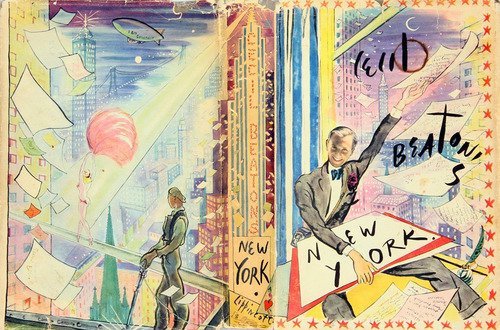 Wraparound book cover (click image for larger version)
Wraparound book cover (click image for larger version)
Alice’s Adventures on Film
 Tatiana's adventures inside a sandwich boardOne of my favourite childhood books was Lewis Carroll’s Alice in Wonderland. So I was very much looking forward to seeing the Wonderland exhibition at the Australian Centre of the Moving Image (ACMI), which explores the many adventures of Carroll’s famous story on film.
Tatiana's adventures inside a sandwich boardOne of my favourite childhood books was Lewis Carroll’s Alice in Wonderland. So I was very much looking forward to seeing the Wonderland exhibition at the Australian Centre of the Moving Image (ACMI), which explores the many adventures of Carroll’s famous story on film.
 The disorienting mirrored Hallway of Doors
The disorienting mirrored Hallway of Doors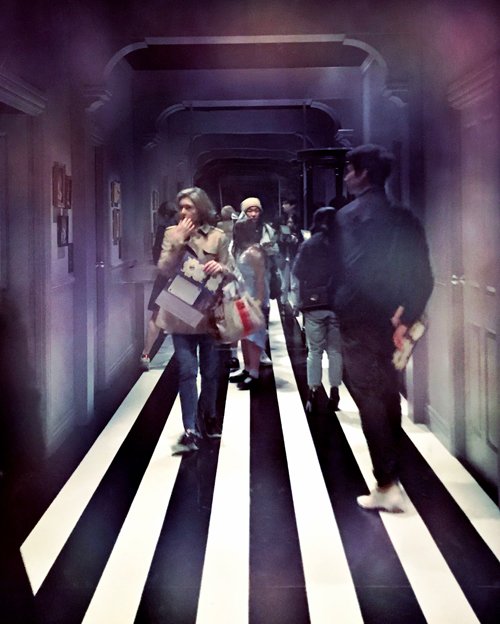 Looking through the two-way mirror into the Hallway of DoorsBeginning with the Hallway of Doors (enter by the smallest door, no matter how old you are), is a series of fantastical rooms, with names such as ‘The Pool of Tears’, ‘Looking Glass House’ and ‘A Mad Tea Party’. On show is charming footage from the late nineteenth century to the multitude of iterations produced in the century since, as well as a plethora of other material such as Charles Dodgson’s original concept drawings, magic lantern projections, vintage posters, animation cels, puppets, props and costumes.
Looking through the two-way mirror into the Hallway of DoorsBeginning with the Hallway of Doors (enter by the smallest door, no matter how old you are), is a series of fantastical rooms, with names such as ‘The Pool of Tears’, ‘Looking Glass House’ and ‘A Mad Tea Party’. On show is charming footage from the late nineteenth century to the multitude of iterations produced in the century since, as well as a plethora of other material such as Charles Dodgson’s original concept drawings, magic lantern projections, vintage posters, animation cels, puppets, props and costumes.
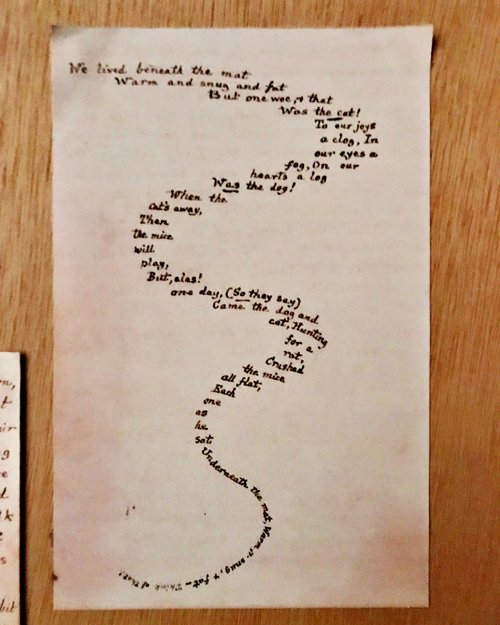 This was always my favourite page in the book when I was very little, so I was thrilled to see Charles Dodgson's original drawing, c1862–64The exhibition is immersive from the get go. On entrance, each attendee is given an ‘enchanted Lost Map of Wonderland’ that unlocks additional surprises with the aid of digital scanners in different rooms of the exhibition – if you could get past the kids hovering over the scanners.
This was always my favourite page in the book when I was very little, so I was thrilled to see Charles Dodgson's original drawing, c1862–64The exhibition is immersive from the get go. On entrance, each attendee is given an ‘enchanted Lost Map of Wonderland’ that unlocks additional surprises with the aid of digital scanners in different rooms of the exhibition – if you could get past the kids hovering over the scanners.
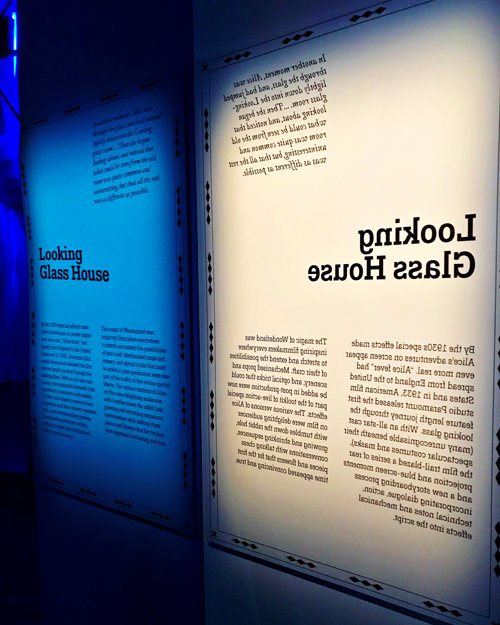 Looking Glass House; the exhibition's curation is thoughtful and thorough, and the design is clever and entertaining for young and old
Looking Glass House; the exhibition's curation is thoughtful and thorough, and the design is clever and entertaining for young and old 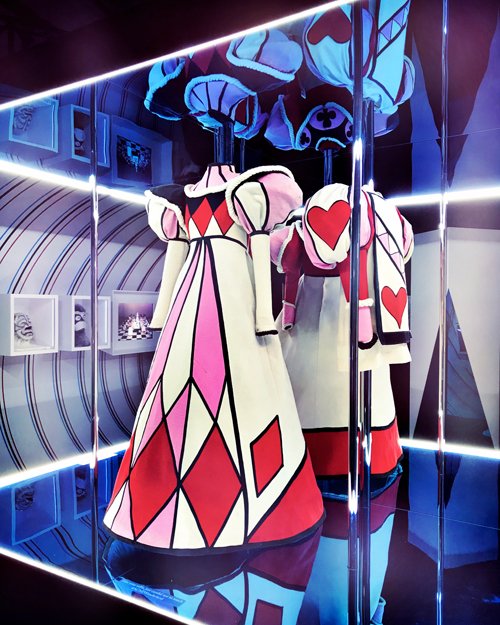 Queen's costumes in Looking Glass HouseThere are also several video installations, and my favourite was at the end, a montage of footage from film, television and advertising showcasing how the story of Alice has entered and utterly saturated popular culture to the present day. I could not help picturing how astonished and gratified Dodgson would be if he could see how far in time and space his story has reached.
Queen's costumes in Looking Glass HouseThere are also several video installations, and my favourite was at the end, a montage of footage from film, television and advertising showcasing how the story of Alice has entered and utterly saturated popular culture to the present day. I could not help picturing how astonished and gratified Dodgson would be if he could see how far in time and space his story has reached.
If you are in Melbourne, the exhibition is running at ACMI every day of the week until 7 October, and is a must-see.
 Clocks
Clocks Inside the video installation of A Mad Hatter's Tea Party
Inside the video installation of A Mad Hatter's Tea Party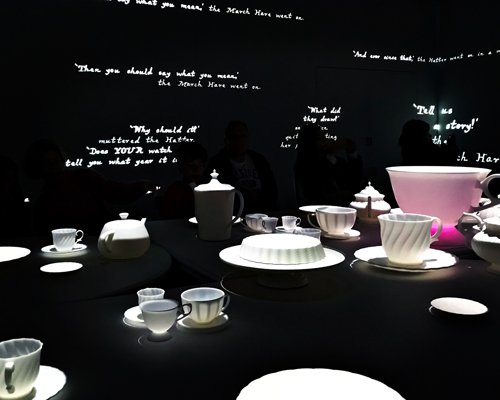 Inside the video installation of A Mad Hatter's Tea Party
Inside the video installation of A Mad Hatter's Tea Party
Killer Diller
 When I was a young teen I went through a short period of enjoying reading the adventures of The Phantom. Those comics were probably my last foray into graphic novels, but apart from the adventuring itself, the vintage forties illustrations were particularly appealing.
When I was a young teen I went through a short period of enjoying reading the adventures of The Phantom. Those comics were probably my last foray into graphic novels, but apart from the adventuring itself, the vintage forties illustrations were particularly appealing.
 Click on the images for larger versionsOn the weekend I picked up a reproduction comic of The Phantom Versus “the Spy Ring” in an op shop for $1, and had fun reading it late yesterday evening. While this story came to a satisfactory conclusion, I had forgotten that these were serial! Damn. Now I’ll always wonder if the Phantom ever ran the spy chief Baron to ground.
Click on the images for larger versionsOn the weekend I picked up a reproduction comic of The Phantom Versus “the Spy Ring” in an op shop for $1, and had fun reading it late yesterday evening. While this story came to a satisfactory conclusion, I had forgotten that these were serial! Damn. Now I’ll always wonder if the Phantom ever ran the spy chief Baron to ground.
I was glad however that his fiancé Diana featured prominently in this story, for I enjoyed her 1940s fashions, especially this beach pyjamas ensemble complete with headscarf and high heels that she wore on the dastardly Baron Danton’s yacht.
I have always hankered for a pair of beach pyjamas, but feel stymied not only by their rarity and expense, but the lamentable fact that any vintage jumpsuit I have tried on has proven to be too short in the body for me. You can see it a bit better in this detailed scan below.
In 40s parlance, aren’t they just killer diller*?
* That would be amazing.





